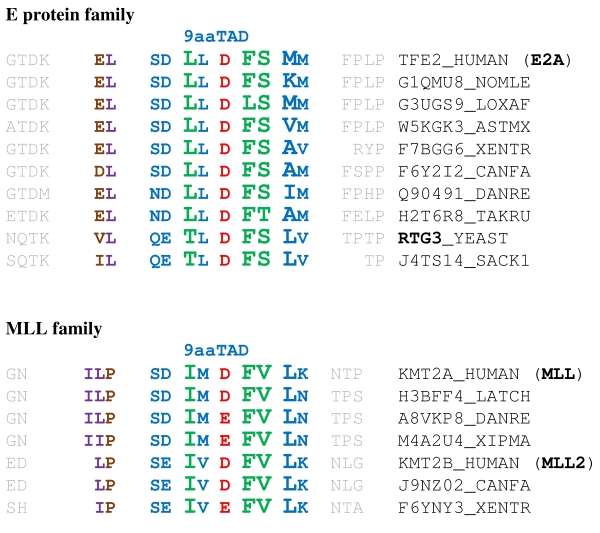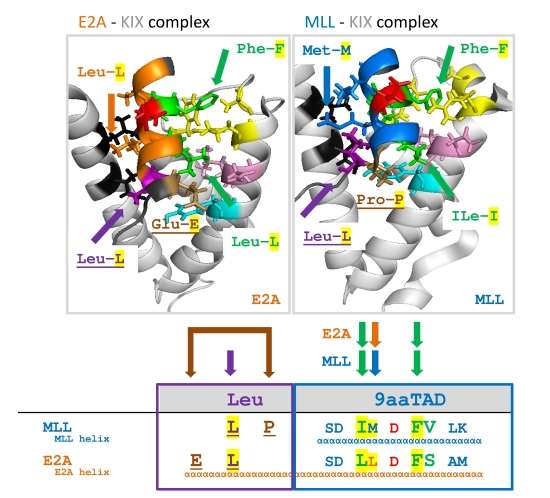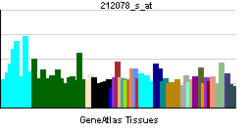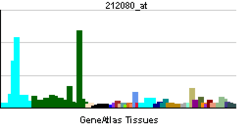KMT2A
| View/Edit Human | View/Edit Mouse |
Histone-lysine N-methyltransferase 2A also known as acute lymphoblastic leukemia 1 (ALL-1), myeloid/lymphoid or mixed-lineage leukemia 1 (MLL1), or zinc finger protein HRX (HRX) is an enzyme that in humans is encoded by the KMT2A gene.[3]
MLL1 is a histone methyltransferase deemed a positive global regulator of gene transcription. This protein belongs to the group of histone-modifying enzymes comprising transactivation domain 9aaTAD[4] and is involved in the epigenetic maintenance of transcriptional memory. Its role as an epigenetic regulator of neuronal function is an ongoing area of research.
Function
Transcriptional Regulation
KMT2A gene encodes a transcriptional coactivator that plays an essential role in regulating gene expression during early development and hematopoiesis. The encoded protein contains multiple conserved functional domains. One of these domains, the SET domain, is responsible for its histone H3 lysine 4 (H3K4) methyltransferase activity which mediates chromatin modifications associated with epigenetic transcriptional activation. Enriched in the nucleus, the MLL1 enzyme trimethylates H3K4 (H3K4me3). It also upregulates mono- and dimethylation of H3K4.[5] This protein is processed by the enzyme Taspase 1 into two fragments, MLL-C (~180 kDa) and MLL-N (~320 kDa).[6][7] These fragments then assemble into different multi-protein complexes that regulate the transcription of specific target genes, including many of the HOX genes.
Transcriptome profiling after deletion of MLL1 in cortical neurons revealed decreased promoter-bound H3K4me3 peaks at 318 genes, with 31 of these having significantly decreased expression and promoter binding.[8] Among them were Meis2, a homeobox transcription factor critical for development of forebrain neurons[9][10] and Satb2, a protein involved in neuronal differentiation.[11]
Multiple chromosomal translocations involving this gene are the cause of certain acute lymphoid leukemias and acute myeloid leukemias. Alternate splicing results in multiple transcript variants.[12]
Cognition and emotion
MLL1 has been shown to be an important epigenetic regulator of complex behaviors. Rodent models of MLL1 dysfunction in forebrain neurons showed that conditional deletion results in elevated anxiety and defective cognition. Interestingly, prefrontal cortex-specific knockout of MLL1 results in the same phenotypes, as well as working memory deficits.[8]
Structure
Gene
KMT2A gene has 37 exons and resides on chromosome 11 at q23.[12]
Protein
KMT2A has over a dozen of binding partners and is cleaved into two pieces, a larger N-terminal fragment, involved in gene repression, and a smaller C-terminal fragment, which is a transcriptional activator.[13] The cleavage, followed by the association of the two fragments, is necessary for KMT2A to be fully active. Like many other methyltransferases, the KMT2 family members exist in multisubunit nuclear complexes (human COMPASS), where other subunits also mediate the enzymatic activity.[14] The 9aaTAD transactivation domains of E proteins and MLL are very similar and both bind to the KIX domain of general transcriptional mediator CBP.[15][16]


Clinical significance
Interestingly, abnormal H3K4 trimethylation has been implicated in several neurological disorders such as autism.[17] Humans with cognitive and neurodevelopmental disease often have dysregulation of H3K4 methylation in PFC neurons.[17][18][19] It also may participate in the process of GAD67 downregulation in schizophrenia.[18]
Rearrangements of the MLL1 gene are associated with aggressive acute leukemias, both lymphoblastic and myeloid.[20] Despite being an aggressive leukemia, the MLL1 rearranged sub-type had the lowest mutation rates reported for any cancer.[21]
Mutations in MLL1 cause Wiedemann-Steiner syndrome and Acute lymphoblastic leukemia.[22] The leukemia cells of up to 80 percent of infants with ALL-1 have a chromosomal rearrangement that fuses the MLL1 gene to a gene on a different chromosome.[21]
Interactions
MLL (gene) has been shown to interact with:
References
- ↑ "Human PubMed Reference:".
- ↑ "Mouse PubMed Reference:".
- ↑ Ziemin-van der Poel S, McCabe NR, Gill HJ, Espinosa R, Patel Y, Harden A, Rubinelli P, Smith SD, LeBeau MM, Rowley JD (December 1991). "Identification of a gene, MLL, that spans the breakpoint in 11q23 translocations associated with human leukemias". Proceedings of the National Academy of Sciences of the United States of America. 88 (23): 10735–9. doi:10.1073/pnas.88.23.10735. PMC 53005
 . PMID 1720549.
. PMID 1720549. - ↑ Piskacek S, Gregor M, Nemethova M, Grabner M, Kovarik P, Piskacek M (June 2007). "Nine-amino-acid transactivation domain: establishment and prediction utilities". Genomics. 89 (6): 756–68. doi:10.1016/j.ygeno.2007.02.003. PMID 17467953.; Piskacek M (November 2009). "Common Transactivation Motif 9aaTAD recruits multiple general co-activators TAF9, MED15, CBP and p300". Nature Precedings: Prepublication research and preliminary findings. doi:10.1038/npre.2009.3488.2.; Piskacek M (November 2009). "9aaTADs mimic DNA to interact with a pseudo-DNA Binding Domain KIX of Med15 (Molecular Chameleons)". Nature Precedings: Prepublication research and preliminary findings. doi:10.1038/npre.2009.3939.1.; Goto NK, Zor T, Martinez-Yamout M, Dyson HJ, Wright PE (November 2002). "Cooperativity in transcription factor binding to the coactivator CREB-binding protein (CBP). The mixed lineage leukemia protein (MLL) activation domain binds to an allosteric site on the KIX domain". The Journal of Biological Chemistry. 277 (45): 43168–74. doi:10.1074/jbc.M207660200. PMID 12205094.; Prasad R, Yano T, Sorio C, Nakamura T, Rallapalli R, Gu Y, Leshkowitz D, Croce CM, Canaani E (December 1995). "Domains with transcriptional regulatory activity within the ALL1 and AF4 proteins involved in acute leukemia". Proceedings of the National Academy of Sciences of the United States of America. 92 (26): 12160–4. doi:10.1073/pnas.92.26.12160. PMC 40316
 . PMID 8618864.; Ernst P, Wang J, Huang M, Goodman RH, Korsmeyer SJ (April 2001). "MLL and CREB bind cooperatively to the nuclear coactivator CREB-binding protein". Molecular and Cellular Biology. 21 (7): 2249–58. doi:10.1128/MCB.21.7.2249-2258.2001. PMC 86859
. PMID 8618864.; Ernst P, Wang J, Huang M, Goodman RH, Korsmeyer SJ (April 2001). "MLL and CREB bind cooperatively to the nuclear coactivator CREB-binding protein". Molecular and Cellular Biology. 21 (7): 2249–58. doi:10.1128/MCB.21.7.2249-2258.2001. PMC 86859 . PMID 11259575.
. PMID 11259575. - ↑ Del Rizzo PA, Trievel RC (September 2011). "Substrate and product specificities of SET domain methyltransferases". Epigenetics. 6 (9): 1059–67. doi:10.4161/epi.6.9.16069. PMC 3225744
 . PMID 21847010.
. PMID 21847010. - ↑ Takeda S, Chen DY, Westergard TD, Fisher JK, Rubens JA, Sasagawa S, Kan JT, Korsmeyer SJ, Cheng EH, Hsieh JJ (September 2006). "Proteolysis of MLL family proteins is essential for taspase1-orchestrated cell cycle progression". Genes & Development. 20 (17): 2397–409. doi:10.1101/gad.1449406. PMC 1560414
 . PMID 16951254.
. PMID 16951254. - ↑ Hsieh JJ, Ernst P, Erdjument-Bromage H, Tempst P, Korsmeyer SJ (January 2003). "Proteolytic cleavage of MLL generates a complex of N- and C-terminal fragments that confers protein stability and subnuclear localization". Molecular and Cellular Biology. 23 (1): 186–94. doi:10.1128/MCB.23.1.186-194.2003. PMC 140678
 . PMID 12482972.
. PMID 12482972. - 1 2 Jakovcevski M, Ruan H, Shen EY, Dincer A, Javidfar B, Ma Q, Peter CJ, Cheung I, Mitchell AC, Jiang Y, Lin CL, Pothula V, Stewart AF, Ernst P, Yao WD, Akbarian S (April 2015). "Neuronal Kmt2a/Mll1 histone methyltransferase is essential for prefrontal synaptic plasticity and working memory". The Journal of Neuroscience. 35 (13): 5097–108. doi:10.1523/JNEUROSCI.3004-14.2015. PMC 4380991
 . PMID 25834037.
. PMID 25834037. - ↑ Takahashi K, Liu FC, Oishi T, Mori T, Higo N, Hayashi M, Hirokawa K, Takahashi H (July 2008). "Expression of FOXP2 in the developing monkey forebrain: comparison with the expression of the genes FOXP1, PBX3, and MEIS2". The Journal of Comparative Neurology. 509 (2): 180–9. doi:10.1002/cne.21740. PMID 18461604.
- ↑ Larsen KB, Lutterodt MC, Laursen H, Graem N, Pakkenberg B, Møllgård K, Møller M (July 2010). "Spatiotemporal distribution of PAX6 and MEIS2 expression and total cell numbers in the ganglionic eminence in the early developing human forebrain". Developmental Neuroscience. 32 (2): 149–62. doi:10.1159/000297602. PMID 20523026.
- ↑ Britanova O, de Juan Romero C, Cheung A, Kwan KY, Schwark M, Gyorgy A, Vogel T, Akopov S, Mitkovski M, Agoston D, Sestan N, Molnár Z, Tarabykin V (February 2008). "Satb2 is a postmitotic determinant for upper-layer neuron specification in the neocortex". Neuron. 57 (3): 378–92. doi:10.1016/j.neuron.2007.12.028. PMID 18255031.
- 1 2 "Entrez Gene: KMT2A lysine (K)-specific methyltransferase 2A".
- ↑ Yokoyama A, Kitabayashi I, Ayton PM, Cleary ML, Ohki M (November 2002). "Leukemia proto-oncoprotein MLL is proteolytically processed into 2 fragments with opposite transcriptional properties". Blood. 100 (10): 3710–8. doi:10.1182/blood-2002-04-1015. PMID 12393701.
- ↑ Mohan M, Herz HM, Shilatifard A (April 2012). "SnapShot: Histone lysine methylase complexes". Cell. 149 (2): 498–498.e1. doi:10.1016/j.cell.2012.03.025. PMID 22500810.
- ↑ Piskacek M, Vasku A, Hajek R, Knight A (March 2015). "Shared structural features of the 9aaTAD family in complex with CBP". Molecular bioSystems. 11 (3): 844–51. doi:10.1039/c4mb00672k. PMID 25564305.
- ↑ Piskacek S, Gregor M, Nemethova M, Grabner M, Kovarik P, Piskacek M (June 2007). "Nine-amino-acid transactivation domain: establishment and prediction utilities". Genomics. 89 (6): 756–68. doi:10.1016/j.ygeno.2007.02.003. PMID 17467953.
- 1 2 Shulha HP, Cheung I, Whittle C, Wang J, Virgil D, Lin CL, Guo Y, Lessard A, Akbarian S, Weng Z (March 2012). "Epigenetic signatures of autism: trimethylated H3K4 landscapes in prefrontal neurons". Archives of General Psychiatry. 69 (3): 314–24. doi:10.1001/archgenpsychiatry.2011.151. PMID 22065254.
- 1 2 Huang HS, Matevossian A, Whittle C, Kim SY, Schumacher A, Baker SP, Akbarian S (October 2007). "Prefrontal dysfunction in schizophrenia involves mixed-lineage leukemia 1-regulated histone methylation at GABAergic gene promoters". The Journal of Neuroscience. 27 (42): 11254–62. doi:10.1523/JNEUROSCI.3272-07.2007. PMID 17942719.
- ↑ Shen E, Shulha H, Weng Z, Akbarian S (September 2014). "Regulation of histone H3K4 methylation in brain development and disease". Philosophical Transactions of the Royal Society of London. Series B, Biological Sciences. 369 (1652). doi:10.1098/rstb.2013.0514. PMC 4142035
 . PMID 25135975.
. PMID 25135975. - ↑ Guenther MG, Jenner RG, Chevalier B, Nakamura T, Croce CM, Canaani E, Young RA (June 2005). "Global and Hox-specific roles for the MLL1 methyltransferase". Proceedings of the National Academy of Sciences of the United States of America. 102 (24): 8603–8. doi:10.1073/pnas.0503072102. PMC 1150839
 . PMID 15941828.
. PMID 15941828. - 1 2 Andersson AK, Ma J, Wang J, Chen X, Gedman AL, Dang J, Nakitandwe J, Holmfeldt L, Parker M, Easton J, Huether R, Kriwacki R, Rusch M, Wu G, Li Y, Mulder H, Raimondi S, Pounds S, Kang G, Shi L, Becksfort J, Gupta P, Payne-Turner D, Vadodaria B, Boggs K, Yergeau D, Manne J, Song G, Edmonson M, Nagahawatte P, Wei L, Cheng C, Pei D, Sutton R, Venn NC, Chetcuti A, Rush A, Catchpoole D, Heldrup J, Fioretos T, Lu C, Ding L, Pui CH, Shurtleff S, Mullighan CG, Mardis ER, Wilson RK, Gruber TA, Zhang J, Downing JR (April 2015). "The landscape of somatic mutations in infant MLL-rearranged acute lymphoblastic leukemias". Nature Genetics. 47 (4): 330–7. doi:10.1038/ng.3230. PMID 25730765. Lay summary – SciGuru Science News.
- ↑ Mendelsohn BA, Pronold M, Long R, Smaoui N, Slavotinek AM (August 2014). "Advanced bone age in a girl with Wiedemann-Steiner syndrome and an exonic deletion in KMT2A (MLL)". American Journal of Medical Genetics. Part A. 164A (8): 2079–83. doi:10.1002/ajmg.a.36590. PMID 24818805.
- 1 2 3 4 5 Yokoyama A, Wang Z, Wysocka J, Sanyal M, Aufiero DJ, Kitabayashi I, Herr W, Cleary ML (July 2004). "Leukemia proto-oncoprotein MLL forms a SET1-like histone methyltransferase complex with menin to regulate Hox gene expression". Molecular and Cellular Biology. 24 (13): 5639–49. doi:10.1128/MCB.24.13.5639-5649.2004. PMC 480881
 . PMID 15199122.
. PMID 15199122. - ↑ Goto NK, Zor T, Martinez-Yamout M, Dyson HJ, Wright PE (November 2002). "Cooperativity in transcription factor binding to the coactivator CREB-binding protein (CBP). The mixed lineage leukemia protein (MLL) activation domain binds to an allosteric site on the KIX domain". The Journal of Biological Chemistry. 277 (45): 43168–74. doi:10.1074/jbc.M207660200. PMID 12205094.
- ↑ Ernst P, Wang J, Huang M, Goodman RH, Korsmeyer SJ (April 2001). "MLL and CREB bind cooperatively to the nuclear coactivator CREB-binding protein". Molecular and Cellular Biology. 21 (7): 2249–58. doi:10.1128/MCB.21.7.2249-2258.2001. PMC 86859
 . PMID 11259575.
. PMID 11259575. - 1 2 Xia ZB, Anderson M, Diaz MO, Zeleznik-Le NJ (July 2003). "MLL repression domain interacts with histone deacetylases, the polycomb group proteins HPC2 and BMI-1, and the corepressor C-terminal-binding protein". Proceedings of the National Academy of Sciences of the United States of America. 100 (14): 8342–7. doi:10.1073/pnas.1436338100. PMC 166231
 . PMID 12829790.
. PMID 12829790. - ↑ Fair K, Anderson M, Bulanova E, Mi H, Tropschug M, Diaz MO (May 2001). "Protein interactions of the MLL PHD fingers modulate MLL target gene regulation in human cells". Molecular and Cellular Biology. 21 (10): 3589–97. doi:10.1128/MCB.21.10.3589-3597.2001. PMC 100280
 . PMID 11313484.
. PMID 11313484. - ↑ Adler HT, Chinery R, Wu DY, Kussick SJ, Payne JM, Fornace AJ, Tkachuk DC (October 1999). "Leukemic HRX fusion proteins inhibit GADD34-induced apoptosis and associate with the GADD34 and hSNF5/INI1 proteins". Molecular and Cellular Biology. 19 (10): 7050–60. doi:10.1128/mcb.19.10.7050. PMC 84700
 . PMID 10490642.
. PMID 10490642.
Further reading
- Marschalek R, Nilson I, Löchner K, Greim R, Siegler G, Greil J, Beck JD, Fey GH (November 1997). "The structure of the human ALL-1/MLL/HRX gene". Leukemia & Lymphoma. 27 (5-6): 417–28. doi:10.3109/10428199709058308. PMID 9477123.
- Eguchi M, Eguchi-Ishimae M, Greaves M (December 2003). "The role of the MLL gene in infant leukemia". International Journal of Hematology. 78 (5): 390–401. doi:10.1007/BF02983811. PMID 14704031.
- Daser A, Rabbitts TH (May 2004). "Extending the repertoire of the mixed-lineage leukemia gene MLL in leukemogenesis". Genes & Development. 18 (9): 965–74. doi:10.1101/gad.1195504. PMID 15132992.
- Li ZY, Liu DP, Liang CC (February 2005). "New insight into the molecular mechanisms of MLL-associated leukemia". Leukemia. 19 (2): 183–90. doi:10.1038/sj.leu.2403602. PMID 15618964.
- Douet-Guilbert N, Morel F, Le Bris MJ, Sassolas B, Giroux JD, De Braekeleer M (January 2005). "Rearrangement of MLL in a patient with congenital acute monoblastic leukemia and granulocytic sarcoma associated with a t(1;11)(p36;q23) translocation". Leukemia & Lymphoma. 46 (1): 143–6. doi:10.1080/104281904000010783. PMID 15621793.
External links
- MLL OMIM Entry: MYELOID/LYMPHOID OR MIXED LINEAGE LEUKEMIA GENE; MLL
- MLL protein, human at the US National Library of Medicine Medical Subject Headings (MeSH)
- Gene MLL on the Atlas of Genetics and Oncology




